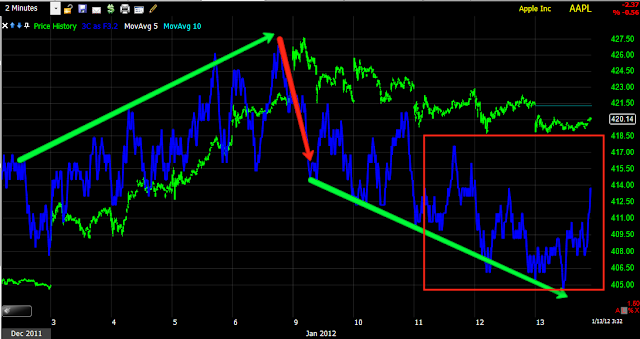You may recall this update on the market, there was an earlier one too showing the same, just a lot more charts. In any case, I didn't put any arrows on it because of time, I was rushing back from my blood draw and wanted to get it out as soon as possible and the divergences were more then clear and didn't need my annotations.
The divergences are much easier to see yesterday (see link to yesterday's post above) as 3C has moved down today in confirmation. The large 3C update, the one in which I asked you to just try to visualize the price/3C trend, was very clear about the action and underlying action throughout this wedge.
DIA, yesterday this divergence in the red box was so clear I didn't have to put any chart annotations. We've seen a slight relative positive divergence off the DIA lows this a.m., relative divergences are not as powerful as the leading divergence in the red box.
Here's a representation of the price wedge which is always suspicious, it is a bearish pattern, but because it is so obvious on the chart, Wall Street knows what traders will do and usually head fakes the pattern, that happened as 3C showed continued heavy distribution. Price is now in the area in which it would confirm the head fake breakout which is the red box on price (the smaller one).
The IWM should perform the best on a rally, it had some of the worst negative divergences like this leading divergence from yesterday. Currently 3C is in line with price action.
The bigger 3C post with something like 30 charts from yesterday showed some of the longer trends like this 2 min. Currently 3C is lagging price and is bearish on the move off the a.m. lows.
The 5 min trend was pretty clear as well, especially given the IWM had made a higher high while 3C trended lower. This chart is in line currently.
The 30 min chart allows us to see the bearish wedge in the market as well as 3C's trend. You can see what s almost certainly the head fake breakout in red around price and the start of confirmation. The lower price moves, the more momentum this false breakout will cause to the downside, this is the point of these head fake moves.
QQQ showed the negative divergence very clearly yesterday, we have a relative positive divergence, but it's not that big of a deal, just intraday jiggles.
Here's the QQQ wedge, this is more extreme and probably had more to do with short covering as the main component, AAPL's trend (price) looked like pure short covering. Again, the head fake breakout combined with the divergence in 3C is a clear bearish signal.
The SPY negative divergence posted yesterday, this is quite clear, especially because the SPY moved to relatively the same price level as the head fake move in the SPY on the 11th, 3C if it confirmed the trend, would be at the same level as it was on the 11th, not moving down. Currently 3C is in line with the price drop, or confirming.
I also posted this 5 min negative divergence
If you looked at the "Broad Market Update" then you would have seen the trend in 3C vs price, and how negative it has been, especially in to the false break out area.
The main reason I've kept my short side conviction can easily be seen in this 30 min chart f the SPY.





























































